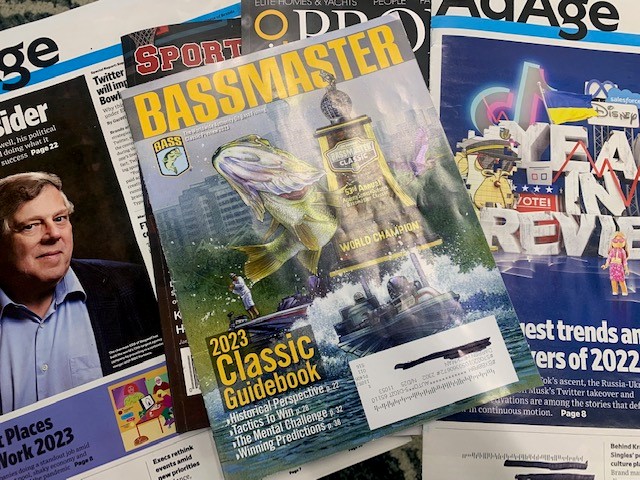Junk In….Junk Out

A couple weeks ago I received a Bassmaster magazine in the mail at work. The 2023 Classic Guidebook edition to be exact. Yep, Darren Heckman, High 5 Communications, who doesn’t work with or represent any clients in the outdoor industry and someone who has never officially went “bass fishing” received the 2023 Bassmaster Classic Guidebook in the mail at work.
As a communications professional, I’m bothered because this approach to direct mail is a big reason why I spend a lot of time convincing clients not all direct mail is junk mail or too expensive when utilized appropriately. As a business owner, I’m bothered by this waste of money.
Bassmaster magazine is published by B.A.S.S., LLC and I’m sure mass mailing their magazine to every PO Box in Jefferson City, MO didn’t really hurt their bottom line. I’m using them as an example because it finally drove me to scribe my opinion on this topic. I’ve been meaning to share my thoughts on this topic for months or least share them with a broader audience than my wife and co-workers.
I recently got the same exact piece of mail four times from a local non-for-profit. And I’m familiar with this non-for-profit enough to know they don’t have money to waste. Organizations, regardless of the size of their budgets, need to do a better job of scrubbing their data.
It’s estimated that each household gets about 848 pieces of junk mail a year (2018-wasteawaygroup.com).
It’s estimated that in 2023, 85% of all emails are spam (dataprot.net).
Whether it’s a letter in the mailbox or a message in the inbox, make sure it’s relevant to the target. Relevant can be based on criteria such as demographics, the location of the person, and/or the timing of the communication. If it’s relevant in at least one of these areas, it’s not junk. And when it’s not junk, direct mail or email marketing can successfully give you the magical ROI data every CEO, CFO or small business owner desires.
Like most activities in life, you get out what you put in. Sending everyone in your email database every email isn’t just lazy, it’s going to cost you customers. Not having a plan for how to manage the “return to sender” pile from your direct mail campaign means your ROI just took a big hit.
Here are three tips to ensure your message reaches the appropriate audience:
- If you purchase a list, for direct mail or email, make sure you are set up to collect/update any incorrect data (returned mail, wrong address, etc.). A part of the financial commitment is not only the purchase cost but also the maintenance/updating cost. Email isn’t free, there is real cost in “pressing send”.
- CRMs are wonderful tools, but most organizations don’t institute best practices for data entry or can’t afford a robust platform. Make sure someone understands how to use Excel or another worksheet platform. An expert in Excel can safe you lots of time and money with regards to making sure databases are clean of duplicates and incomplete records.
- Always drive your direct mail or email recipients to a specific action. If you have a physical location or store front, of course this will be your ROI-indicator. But for most, it’s a web site. Don’t send everyone to the home of your web site, send them specifically to a part of your web site pertaining to your message. Learn from every interaction.
Today more than ever, data is available and usable to target those who want to hear more about your product, service, mission, whatever. A recent article in Financial Brands E-Newsletter stated “personalization builds trust”. Direct mail and email are tactics that provide you the opportunity to build trust. Database management is ongoing and thus costs money, but the investment is worth it.